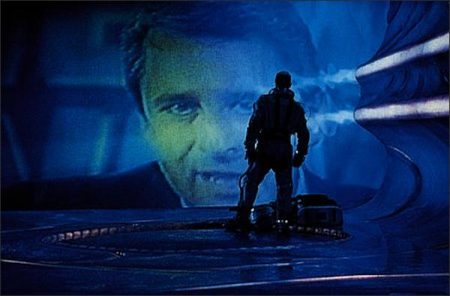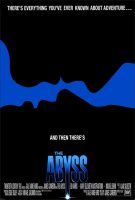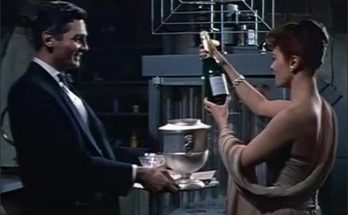Taglines: A place on earth more awesome than anywhere in space.
The Abyss movie synopsis. In 1988, the U.S. Ohio-class submarine USS Montana has an encounter with an unidentified submerged object and sinks near the Cayman Trough. With Soviet ships moving in to try to salvage the sub and a hurricane moving over the area, the U.S. government opts to send a SEAL team to Deep Core, a privately owned experimental underwater drilling platform near the Cayman Trough to use as a base of operations. The platform’s designer, Dr. Lindsey Brigman, insists on coming along with the SEAL team, despite her estranged husband Virgil “Bud” Brigman being the current foreman.
During initial investigation of the Montana, a power outage in the team’s submersibles leads to Lindsey seeing a strange light circling the sub. At the same time, one of Deep Core’s crew, “Jammer”, damages his breathing apparatus in an apparent panic, and falls into a coma. This prompts the admiral in charge of the operation to send Lt. Coffey, the SEAL team leader, to take one of the mini-subs and recover a Trident missile warhead from the Montana, just as the storm hits above.
Coffey does not get permission from the Deep Core crew. The Benthic Explorer, which Deep Core is tethered to, is rocked by the storm, and the cable crane is torn from the ship. The crane falls into the trench and, without the mini-sub to disconnect the cable, Deep Core is dragged towards the trench, stopping just short of it. The rig is partially flooded, killing several crew members and damaging its power systems. Coffey shows little remorse when he and his SEALs return to the damaged base.
The Abyss is a 1989 American science fiction film written and directed by James Cameron, starring Ed Harris, Mary Elizabeth Mastrantonio, and Michael Biehn. When an American submarine sinks in the Caribbean, the US search and recovery team works with an oil platform crew, racing against Russian vessels to recover the boat. Deep in the ocean, they encounter something unexpected. This movie was released on August 8, 1989 and received positive reviews, but under-performed at the box office.
Film Review for The Abyss
”The Abyss” was made in 7.5 million gallons of water in a concrete containment tank at an abandoned nuclear power station. ”There was never any radioactive material on the site. I don’t go anywhere near that far for art,” says Gale Anne Hurd, who produced the movie about an underwater oil rig, a drowned nuclear submarine, a hurricane, a failed marriage and sea-dwelling aliens.
If the actors, director and crew of ”The Abyss” did not expose themselves to nuclear contamination, that was about the only thing they avoided. James Cameron, who had previously directed ”The Terminator” and ”Aliens,” wanted to make an underwater film without cheating. So 40 percent of ”The Abyss,” which opens Friday, took place in the murky darkness of A and B tanks at the Cherokee Nuclear Power Station outside Gaffney, S. C. And no stunt divers swam in place of the actors.
”It was a bitch,” says Ed Harris. ”It was pretty hairy.” The words are flat and lack intonation. They might have been spoken by the character he plays, the blue-collar roustabout who is the movie’s hero. Now it is all over but the launching. According to 20th Century-Fox, ”The Abyss” cost $43 million. Executives at other studios think it may have cost more. Two less ambitious underwater efforts – ”Deep Star Six” and ”Leviathan” – have recently failed at the box office. ”The Abyss,” which was originally to have opened July 4, was delayed for more than a month by production and special-effects problems, resulting in a late start on the summer. And Fox must teach a considerable portion of the American public what the word ”abyss” means.
There were reports from South Carolina that Mr. Harris was so angered by the physical torment of the film and the autocratic ways of Mr. Cameron that he said he would refuse to help sell the picture. Mr. Harris denies that he has any animosity. Polite and soft-spoken, he showed up at Fox’s press junket for the film last weekend.
This is not to say that his memories lack pain. For weeks, he was encased in a suit where he appeared to be breathing fluid rather than air. Breathing the fluid, which filled his suit, would supposedly allow his character to descend into a bottomless pit in the floor of the Caribbean Sea. Such a fluid actually exists. It was tested once on a scientist – who nearly died -and over the last 20 years has been tested on numerous animals, which survived. In one of the movie’s most uncomfortable scenes, a white rat is really locked in a box of the liquid fluorocarbon.
Movie stars being less expendable than rats, Mr. Harris held his breath inside a helmet full of liquid while he was being towed 30 feet below the surface of the tank. When he could no longer hold his breath, he pushed open his face plate and Al Giddings, a professional diver who was shadowing him, swam over to push a regulator attached to an oxygen tank into his mouth.
”The worst moments for me were being towed with fluid rushing up my nose and my eyes swelling up,” says Mr. Harris. ”Once, the regulator was put in upside down so that one-half of what was going into my lungs was water. For a brief second, I thought, ‘This is it,’ before Al swam over and put the regulator in right. And then I was mad at myself for feeling that panic.” He was not the only actor to feel panic.
”I had to play mind games with myself any time I had the helmet on,” says Mary Elizabeth Mastrantonio, who plays Mr. Harris’s estranged wife and the designer of Deepcore, the submersible oil rig on which Mr. Harris works. ”I can be as hardy as the next person but only for a limited period of time. I don’t have the stamina. To keep from being panicked, I had to stare at the surface where the light was coming from.” But what happened when there was no light? Michael Biehn is a strong swimmer, the winner of YMCA breaststroke races during the summers of his youth.
”But we were weighted down to the bottom of the tank,” he says. ”There were weights on our ankles and waist. If something went wrong, we couldn’t swim to safety.” Mr. Biehn plays the closest thing the movie has to a villain, a Navy lieutenant who goes crazy with water-pressure-induced psychosis. ”Once, we lost all power,” he says. ”It went completely black. It took 90 seconds of panic before I realized I was carrying a prop flashlight and turned it on and everybody gathered around the light.”
Despite the fact that James Cameron movies meld state-of-the-art hardware with relentless action and dangerous special effects in creepy environments, no one has ever been seriously injured on one of his films. On ”The Abyss,” there were only the ear infections that are an occupational hazard for divers. And, when the smaller tank was overchlorinated, the hair of some of the divers was bleached or burned off.
What Mr. Cameron labels his ”autocracy” is his response to danger. ”I want total control,” he says. ”I will throw myself back to see what I’m going to hit before I let one of the actors do it.”
The Abyss (1989)
Directed by: James Cameron
Starring: Ed Harris, Mary Elizabeth Mastrantonio, Michael Biehn, Leo Burmester, Todd Graff, John Bedford Lloyd, Kimberly Scott, Christopher Murphy
Screenplay by: James Cameron
Production Design by: Leslie Dilley
Cinematography by: Mikael Salomon
Film Editing by: Conrad Buff, Joel Goodman, Steven Quale
Costume Design by: Deborah Everton
Set Decoration by: Anne Kuljian
Art Direction by: Peter Childs, Russell Christian
MPAA Rating: PG-13 for language and some scenes of action.
Music by: Alan Silvestri
Distributed by: 20th Century Fox
Release Date: August 9, 1989
Visits: 96





